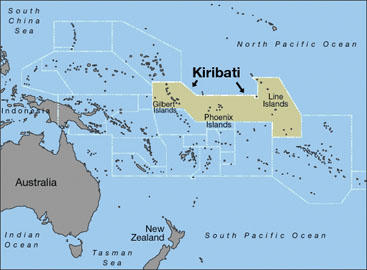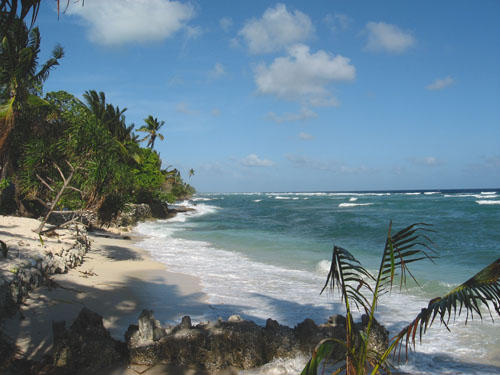The Aquarium of the Pacific in Long Beach has extended its conservation efforts across the ocean to the island nation of Kiribati, located approximately halfway between Australia and Hawaii. The Long Beach icon joined the board of the Phoenix Islands Protected Area (PIPA), one of the world’s largest marine protected areas, which covers one of three island groups that make up Kiribati.

The island nation of Kiribati is made up of three archipelagos: the Gilbert, Phoenix and Line islands and is located approximately halfway between Australia and Hawaii.
Anthony Brown, the Aquarium’s vice president of finance and chief financial officer, made a trip to the islands in December. Kiribati (pronounced Kiri-bas) is made up of three archipelagos: the Gilbert, Phoenix and Line islands. The Aquarium plans to focus its efforts in Tarawa, Kiribati’s most developed island. Brown will oversee the finances related to PIPA initiatives.
“The people seem very happy,” Brown said of Tarawa, located in the Gilbert island chain. “The island is beautiful, but faces a lot of challenges like cleanliness and the long-term answer to the rising sea level. Unfortunately, there’s a lot of trash that washes up on the beach. There’s zero tourism because there are a number of conservation issues this country is faced with.”
According to information from the Aquarium, the PIPA protected area was created in 2006 to safeguard the coral reefs and preserve the ecosystem, which is largely free of human impacts. The protected area is about 157,626 square miles and is located five degrees south of the equator. Only about 25 people live on the Phoenix Islands, and they are government employees and their families.
One goal of PIPA is to establish a learning center for conservation-related issues at Betio Elementary School, located in Betio, Tarawa’s largest city. The school has already implemented programs to teach recycling.
“We hope to extend our goal of teaching conservation,” Brown said. “Tarawa is subject to sea level rise. The island is projected to be uninhabitable in 35 to 50 years. Nearly 60,000 people somewhere down the line are going to become refugees, and it’s the kids who’re going to have to make those tough decisions. It’s not immediate, but the best that can be done is to educate everyone, and especially the kids.”

To improve the environment, PIPA established the Clean Green and Blue Project in Betio. Its slogan is “clean, to green, to blue.” One of its past initiatives was to plant mangrove trees to assuage the sea level rise. Mangroves thrive in hot, salty conditions that would kill most other plants. Their thick, intertwined roots serve as a barrier for rising water, according to Brown. The Clean Green and Blue Project has also organized beach cleanups.
“We saw firsthand how kids at Betio Elementary are participating in a reuse and recycle program. They were making things out of plastic,” Brown said. “I saw a big rice bag converted into a handbag. It was a very creative effort.”
To encourage education, the PIPA board awarded a scholarship to a Kiribati native who is studying marine biology at Scripps College in Claremont, California.
“When the island sinks, [the people] need to have the skill knowledge to be sustainable somewhere else,” Brown said. “There’s no silver bullet solution. And they have to live there [in Kiribati] in the meantime. Efforts toward education and conservation have to go a long way.”
According to Brown, the Aquarium may feature an exhibit on Tarawa and the environmental challenges the residents are facing. Kiribati is also expected to have more representation in the Aquarium’s annual Pacific Islander Festival in June. The event features music, dance and cultural crafts from island nations such as Fiji, Hawaii and Tahiti. The next meeting of the PIPA board and Kiribati government officials is expected to take place at the Aquarium next month.
